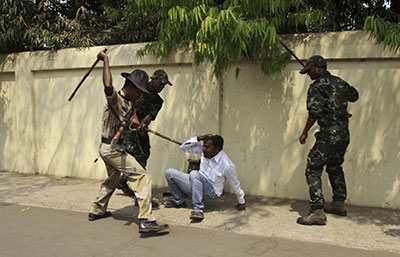Anyone who has been to India or is familiar with the country knows how chaotic it can be: from the congestion on the streets of Delhi to the messy way in which democracy functions. And for journalists, covering the chaos of India can be risky business. This week alone, Indian law enforcement officials assaulted two journalists covering demonstrations in different corners of the country.
On Monday, seven officers belonging to a security force in eastern Odisha state allegedly beat Subhakanta Padhiary, a correspondent for an unspecified Odiya-language daily, while he was covering demonstrations staged by members of the opposition party outside the chief minister’s home. “All of a sudden about seven [officers] came to our bike and started beating me with lathi [sticks]. They continued thrashing us even after we showed them our ID card,” Padhiary told local media. One senior police officer even walked away from the scene as officers continued beating the scribe, reports said.
A day later, in India’s restive, northern-most state of Jammu and Kashmir, police officers attacked Muneeb-ul-Islam, a photojournalist for local news agency Current News Service, as he was covering demonstrations outside a local hospital related to a young man’s mysterious death. “I was attacked by policemen with bamboo sticks continuously for 15 minutes,” he told CPJ by email. While two senior police officers intervened to stop the assault, they also directed an officer to confiscate Islam’s camera. The officer forced Islam to delete his photographs.
Assaults like these are not uncommon in the world’s largest democracy. While neither journalist was seriously injured in these recent assaults, covering demonstrations can turn deadly in India. During nationwide protests against sexual assault that broke out in December, cameraman Dwijamani Singh of the Prime News channel was shot dead by police in Imphal, the capital of the northeastern state of Manipur. Later that month, police fired tear gas and water cannons to disperse journalists and demonstrators on the streets of Delhi and beat them with batons.
These assaults are emblematic of India’s failure to respect members of the press. In the Odisha incident, two officers were suspended, according to local reports. In the Kashmir incident, no action has been taken against the offending officers, Islam told CPJ. And in Singh’s case, the Manipur state government ordered a probe into the killing, but the results have not been made public, according to news reports. India’s National Human Rights Commission has called for “appropriate action” to be taken, but there is no indication that anyone has been held to account, according to the reports.
The Indian Reserve Battalions fall under the jurisdiction of the central government and the police fall under the purview of the various state governments. It is high time that these law enforcement bodies be trained not to attack the press and to spread a clear message that such attacks are completely unacceptable in a democracy. Taking swift, severe action against these purported guardians of the law is one way to ensure that the message does not get lost in India’s chaos.
